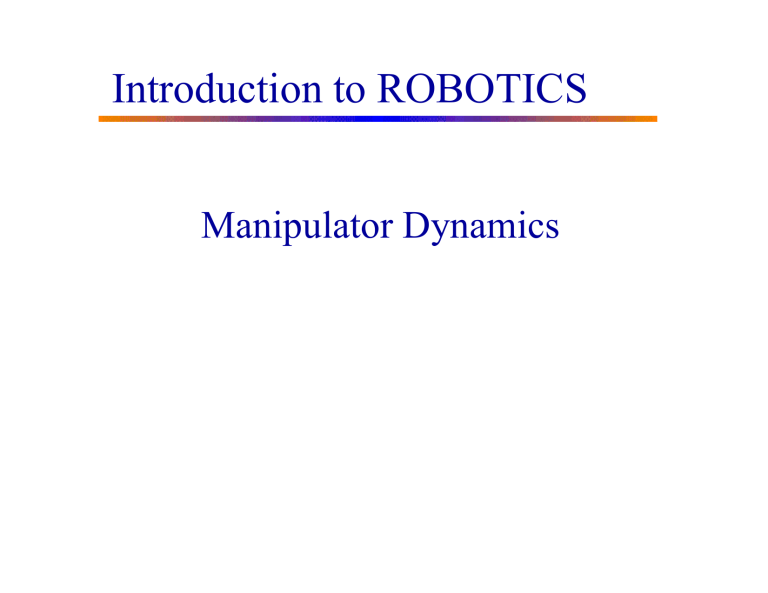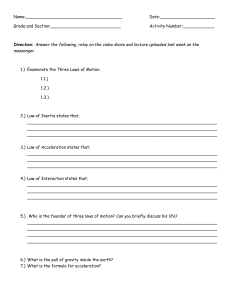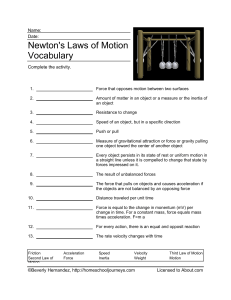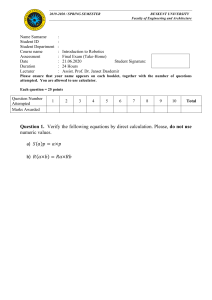Manipulator Dynamics in Robotics: Newton-Euler Algorithm
advertisement

Introduction to ROBOTICS
Manipulator Dynamics
Manipulator Dynamics
• Mathematical equations describing the
dynamic behavior of the manipulator
– For computer simulation
– Design of suitable (model based) controllers
– For evaluation and insight into the structure of the
robot system
– Joint forces/torques
Robot motion, i.e.
acceleration, velocity, position
Forward/Inverse Dynamics
Forward
;
;
Dynamics
Inverse
Robot Motion
Joint Forces/Torques
Equations of Motion
• The way in which the motion of the
manipulator arises from forces/torques applied
by the actuators, or from external
forces/torques applied to the manipulator.
Two Most Applied Approaches
• Energy based: Lagrange-Euler
Simple and symmetric
• Momentum/force approach: Newton-Euler
Efficient, derivation is simple but messy,
involves vector cross product. Allows real
time control
Newton-Euler Algorithm
• Newton-Euler method is described in next
slides. The goal is to provide a big picture
understanding of this method without getting
lost in the details.
• This approach includes two phases:
Forward (Kinematic) Phase
Backward (Kinetics) Phase
Newton-Euler Algorithm
• Forward Phase
– First compute the angular velocity, angular acceleration,
linear velocity, linear acceleration of each link in terms of
its preceding link.
– These values can be computed in recursive manner, starting
from the first moving link and ending at the end-effector
link.
– The initial conditions for the base link will make the initial
velocity and acceleration values to zero and g, respectively.
Newton-Euler Algorithm
• Backward Phase
– Once the velocities and accelerations of the links
are found, the joint forces can be computed one
link at a time starting from the end-effector link
and ending at the base link.
Newton-Euler Algorithm; Forward Phase
Angular Velocity
Newton-Euler Algorithm; Forward Phase
Angular Velocity
Prismatic Joint:
Revolute Joint:
Newton-Euler Algorithm; Forward Phase
Linear Velocity
Newton-Euler Algorithm; Forward Phase
Linear Velocity
Prismatic Joint:
Revolute Joint:
Newton-Euler Algorithm; Forward Phase
Angular Acceleration
Newton-Euler Algorithm; Forward Phase
Angular Acceleration Prismatic Joint:
Revolute Joint:
Newton-Euler Algorithm; Forward Phase
Linear Acceleration
Newton-Euler Algorithm; Forward Phase
Linear Acceleration
Prismatic Joint:
Revolute Joint:
Newton-Euler Algorithm; Forward Phase
Linear Acceleration of center of mass
For Both Revolute and Prismatic Joints:
Newton-Euler Algorithm; Backward Phase
Inertial Forces and Moments
Inertia
• If a force acts of a body, the body will accelerate. The
ratio of the applied force to the resulting acceleration
is the inertia (or mass) of the body.
• If a torque acts on a body that can rotate freely about
some axis, the body will undergo an angular
acceleration. The ratio of the applied torque to the
resulting angular acceleration is the rotational inertia
of the body. It depends not only on the mass of the
body, but also on how that mass is distributed with
respect to the axis.
Mass Distribution
Inertia tensor- a generalization of the scalar moment of inertia
of an object
Moment of Inertia
The moment of inertia of a solid body with density (r )
w.r.t. a given axis is defined by the volume integral
I (r )r 2 dv,
where r is the perpendicular distance from the axis of
rotation.
Moment of Inertia
Moment of Inertia can be broken into components as:
I jk mi ri 2 jk xi , j xi ,k
for a discrete
distribution of mass
for a continuous
distribution of mass
i
2
I jk (r ) r jk x j xk dV
V
y2 z2
I ( x, y, z ) xy
V
xz
xy
z 2 x2
yz
xz
yz dxdydz.
x 2 y 2
Moment of Inertia
The inertia tensor relative to frame {A}:
I xx I xy I xz
A
I I xy I yy I yz ,
I xz I yz I zz
Mass moments of inertia
x
x
z dv,
y dv,
I xx y 2 z 2 dv,
V
I yy
I zz
2
V
2
V
2
2
Mass products of inertia
I xy xydv, I xz xzdv, I yz yzdv.
V
V
V
Newton-Euler Algorithm; Backward Phase
Force Equation
Newton-Euler Algorithm; Backward Phase
Moment Equation
Newton-Euler Algorithm; Backward Phase
Joint Force/Torque
Prismatic Joint:
Newton-Euler Algorithm; Backward Phase
Joint Force/Torque
Revolute Joint:
Inclusion of Gravity Forces
• The effect of gravity loading on the links can be
included by setting
, where g is the
gravity vector.
The Structure of the Manipulator Dynamic Equations
M (q)q C(q, q) G(q)
M (q) : n n
C (q, q ) : n 1
G (q ) : n 1
: mass matrix
: centrifugal and Coriolis terms
: gravity terms
The Structure of the Manipulator Dynamic Equations
The Structure of the Manipulator Dynamic Equations
The Structure of the Manipulator Dynamic Equations
• G(q)=?



